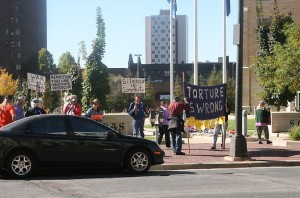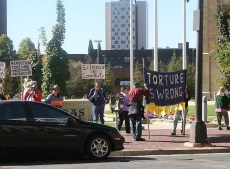During the civil rights movement of the 1960s, universities were the location for many protests. Students and supporters demonstrated about controversial issues to raise awareness for their causes. In today’s world we have no shortage of controversies and causes, so why aren’t there as many demonstrations?
St. Thomas could benefit from more demonstrations and protests on campus. Students should feel passionate enough about their causes to share information with others. From passing out fliers to picketing the campus sidewalks, these acts of protest open the door for conversations on campus.

The university’s student bill of rights includes a portion acknowledging students’ right to protest. According to that document, “The University of St. Thomas recognizes that free inquiry and free expression are indispensable elements for the achievement of the goals of an academic community. Students have the right to freedom of expression.”
But St. Thomas has experienced few protests in my four years here on campus. During the fall semester of 2010, one protest on campus has been large enough to gain attention. A group protested St. Thomas law professor Robert Delahunty and co-author John Yoo, claiming their involvement in Bush administration memos led to torture of international prisoners in U.S. prisons.
In the 2009-2010 school year, two protests come to mind. The first was an anti-war demonstration against the war in Iraq lead by Students for Justice and Peace. The demonstration included a drum circle and informational booths, which raised awareness of statistics from the war.
Speaking out against speakers
In the spring of 2010, one of the largest protests in campus history took place. Students and other supporters protested speakers on campus for a non-university-affiliated event. The speakers supported legislation against gay marriage. The people protesting were speaking out against what they believed was an unfair speaker policy at the university.
Through this protest, students and other supporters of the demonstration were brought together for a common cause. The GLBT community was strengthened on campus and an important issue was brought to light. The university’s speaker policy has been heavily debated since the demonstration. Without the demonstration, conversations about the university’s speaker policy would not have been nearly as prevalent.
Protests open the door for discussions. Regardless of one person’s view on an issue, a protest gives people a vehicle to express their opinions. I consider a university, especially St. Thomas, a marketplace of ideas. Demonstrations are an excellent way to make others aware of ideas, opinions and problems on campus.
Gina Dolski can be reached at grdolski@stthomas.edu.


A conversation is an exchange of ideas between two parties. Since protest are almost universally a single sided affair, I find it hard to believe that protests, “open doors for conversation”. Nothing is discussed at a protest. One side of an argument is affirmed, while the other side is [usually] misrepresented. If anything, protests inhibit conversation by polarizing the audience.
Fortunately, we have a much better medium for expressing our disagreements, namely the Internet. For example, I could write an opinions article to TommieMedia about the protest last spring and the protester’s complete disregard of the University’s noise policy. Within a few days, there would be a genuine conversation among the comments of that article. For that (and public safety briefs), I am very thankful for TommieMedia.
I actually believe that a large part of the writer’s point (and correct me if I’m wrong, Gina) is to bring to light the fact that protests tend to OPEN DOORS for conversation. An actual act of public protest is definitly not a conversation in and of itself, mostly because the reason communities feel a protest is necessary is because there is some inequality in whose ideas/opinions are valued, which in some cases stems from or evern leads to a complete disregard for any type of conversation, consideration, or compassion. However, I would assume, from personal experience as well as logical thought, that protests almost always lead to some conversation- whether it’s between the two differing perspectives or within the majority. And anything that can create something as beautiful as conversation is pretty powerful and undoubtedly necessary, at least in my opinion.